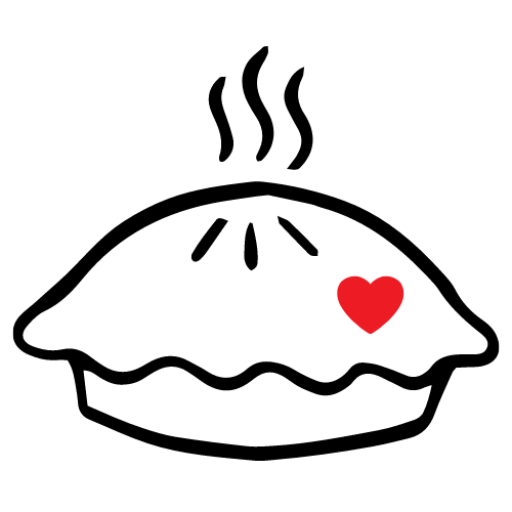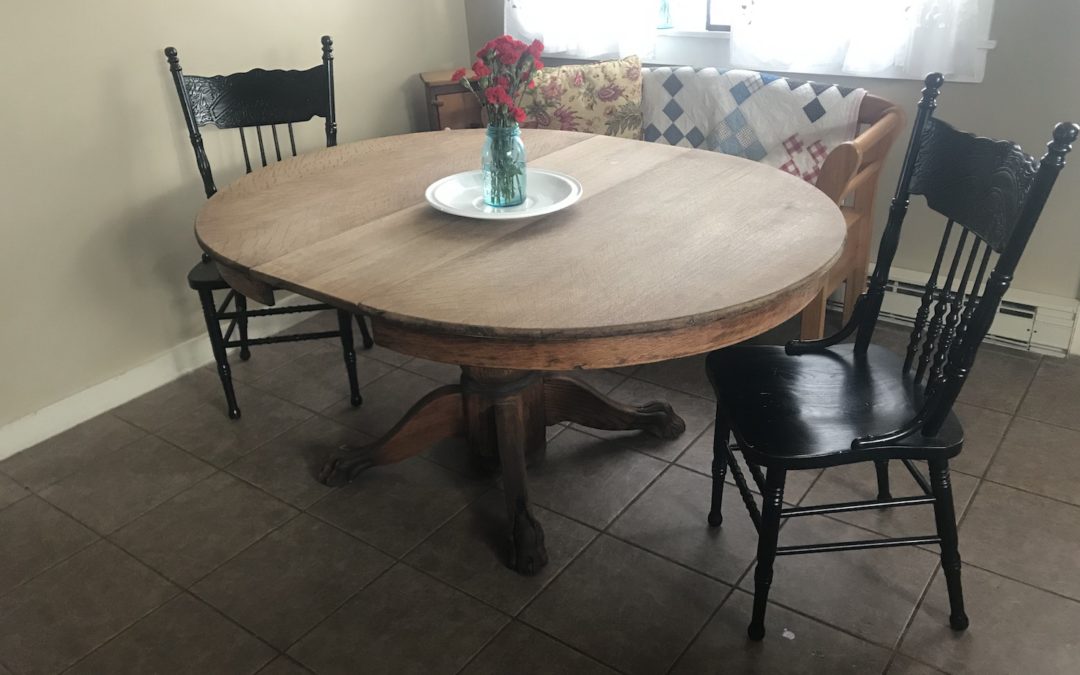In the old, oak table, I saw a bargain, potential and a bridge between loved ones who barely met. And — I had something to prove to myself.
On my hands and knees one muggy August afternoon, I scraped rubbery, dark slime from the round top of an oak pedestal table. Decades of varnish and dirt slowly yielded to my relentless rubbing of coarse sandpaper over the sticky surface.
That old finish took its revenge. Some of it re-settled upon my skin, mixing with my salty sweat, coating the lenses of my glasses and working its way into my nostrils.
Disgusting. Most people — “normal,” saner, smarter people — would have skipped this grimy job. They would have dragged this wobbly table with its scarred, sticky finish out to the curb long ago and purchased a nice, new table.
But not me.
The Object of my Obsessions
In my mind’s eye, I saw how beautiful it could be with its simple, thick round top and luscious curves. Its oval swirls of grain in the pedestal base and its clawed feet. I saw our family sitting together, having dinner around it, in front of the big kitchen window.
I saw a bridge between my parents, who passed on a love of well-made, timeless objects, and the family I found with my husband and stepsons. This table connects people dear to me who barely had a chance to meet.
I saw a small victory against the wasteful, throw-a-way society we’ve become.
And I had something to prove to myself about finishing. Like my Dad, I collect fixer-upper objects, and projects that can pile up. An old door here, an old window there. A house. And before you know it, you’re drowning in a wild sea of unfinished things in need of this or that.
How many is too many? When you’re overwhelmed, I guess. No peace there.
A Broken Promise
When I was in fourth grade, ready to start piano lessons, my Dad gave me an upright fixer-upper, out-of-tune piano with a crackled dark cherry finish. He promised to re-make it into a beautiful instrument. He’d work on it Saturday mornings at the duplex where I lived with my Mom after their divorce. He worked hard, stripping the dark finish away.
I can still see him lying on the old pine dining room floor, with the tip of his tongue hooked around the corner of his mouth in concentration, just like his own father would lie on the grass alongside his tomato plants on a summer afternoon, checking the fruit.
With Dad’s elbow grease, the piano’s finish melted off, leaving behind streaks of dark burgundy and dusky rose with bare, pinkish wood.
But then he stopped coming over — who-knows-why. With adult eyes, I wonder what else was going on in his life. Maybe he was doing his best to just stay afloat.
The abandoned, out-of-tune piano sat idle in the dining room, a constant, ugly reminder of a broken promise. That Christmas my Mom somehow found a way, as she always did, and bought a handsome new chestnut piano and I started lessons. She had the old piano hauled away.
So I was committed to restoring that oak pedestal table, to finishing this project.
Actually, I was obsessed.
As I worked that humid day, I caught glimpses of the bare beauty of the striped tiger oak top and the grain of the base. Enough to keep going.
Preparing to Celebrate
Just before Thanksgiving, years before then, a local antiques dealer had dropped the table off on the front porch of my 1900 folk Victorian. The year had been full with grieving a marriage, and making the house my own. A year of rich growth, deep friendship and long walks along Spring Creek.
I was ready to celebrate, and host my first Thanksgiving dinner. Over months, I’d paid the antiques guy a little here and there for my bargain table. Cosmetics were for later.
I brought the table inside and cleaned it up. A good, helpful friend made two perfect table leaves so we could fully extend it. I shimmed a leg to help with the wobble and draped it in a borrowed, cream damask cloth. Done.
My Dad and Stephanie, his long-time girlfriend, drove from Ohio and brought two oak dining chairs from his stash of treasures.
He didn’t yet know: I’d met a wonderful man at a Halloween party. Maybe we would get together Thanksgiving evening.
Maybe. Too soon to tell. It was a secret.
As the turkey cooked, Dad and I hung pictures on the walls to finish the room. Finishing. I caught him looking at me, wondering.
He’d seen me so sad for so long, comforted me with visits and pep talks — even once wisely said nothing and simply hugged me as I sobbed in a meltdown over lost drill bits.
“You look really happy,” he said.
“I am, Dad. I’m good.” I smiled.
Sharing the Holiday Glow
That evening, when the dishes were cleared and all my guests including Dad and Stephanie had departed, the kind and handsome man who is now my husband first visited my home, a lovely holiday scene of white linen, flickering candles and flowers against walls freshly painted a rich, burnt-orange.
Like being inside a flame.
“Hope you like orange!,” I’d said.
Mike and I relaxed on the couch, sipping the wine he’d brought, talking and enjoying getting to know each other. (Read You Had Me at Pears.)
By the next November, chemo treatments had left my dad weak and ashen, battling and hoping. That Thanksgiving at the wobbly, old oak table was Dad’s last healthy one. The next year, 2012, brought the deepest sorrow of my life as I lost my Dad. So many times over his final months he told me he was not ready to leave his family. He wasn’t finished.
Those 12 short months also brought the greatest joy and bliss as I gained the love of my life and his sons — now our family.
Sign-up to Receive Each Week’s Story in Your In-Box!
A Better Bargain?
We moved the oak table to the kitchen of our home and sold the folk Victorian. One day, my husband’s aunt — a smarter, saner woman — eyed the base and remarked she’d had a table just like it, but hers wobbled and had a stain in the top of the striped tiger oak so they had gotten rid of it. We pulled the tablecloth and the stain matched the one in her memory. Who knows? Maybe.
I know what my deal-hunting Dad would say: “You should have waited. Maybe you could have gotten it for FREE!”
Finally, I was more stubborn than that old finish. The bare beauty of the grain came through in soft reds and golds, and gentle browns. A wash with wood bleach removed the stains. I left some rough patches, and sealed it with beeswax and citrus oil.
Pretty. Still, the top wobbled.
Some Tender Loving Care
So a few years ago, my father-in-law and I loaded the table in his pickup and took it to his Amish woodworker friend who re-built the attachment between the base and top.
Now, the table smoothly slides as it was meant to, and at Thanksgiving is the kids’ table. Our niece just decorated a golden piece of fabric with paint splatters and sparkles for it. By next Thanksgiving, gold glitter will settle into the table’s deep crevices forever.
As we work on renovating our 1860s home, the oak table and its finish has faded. I picked up a can of Restore-a-Finish and some beeswax with citrus oil to give it some tender loving care. We’ll never run out of projects around here. Thank goodness for my husband’s patience with my obsessions.
Of course it’s important to finish things, follow-through and keep promises. Good for the soul and peace of mind. Sharing objects is much better when they look good and function well.
Yet, I must wonder: Are we ever really finished?
I can’t imagine ever not starting new projects, chasing visions and working to realize all of the full potential in this life. It’s just too much fun.


Another great story! Thank you Lisa!
Thank you Bev!
I envy your obsession and spunk!
I always thought that table was beautiful. Lisa, I love the way that you see the potential and value of antiques and unusual objects. But more so, you understand the value of relationships as well.
Oh thank you for these kinds words. Yes – the objects are just things. Connection is what’s most important. Thank you for being here!
Another lovely story Lisa. Thanks for sharing.